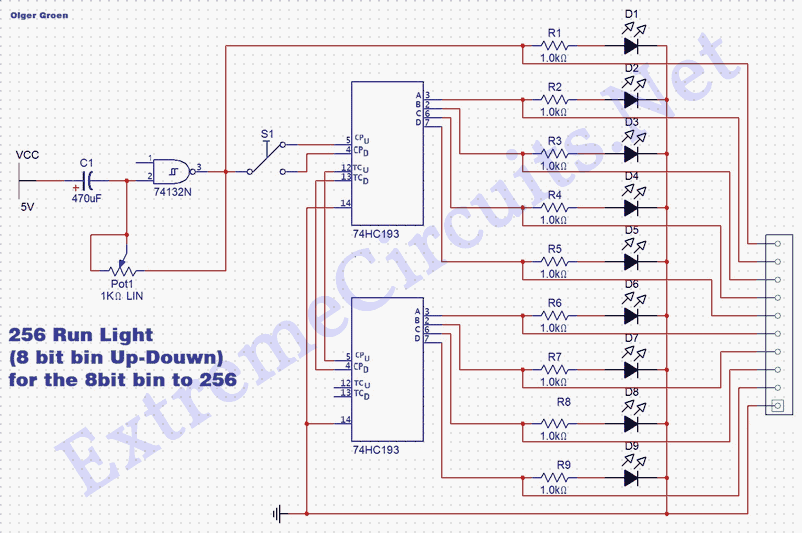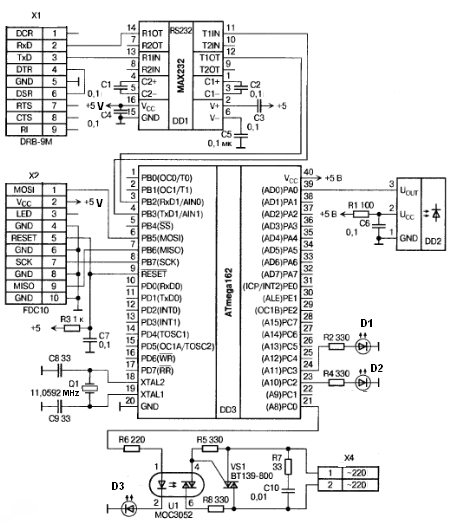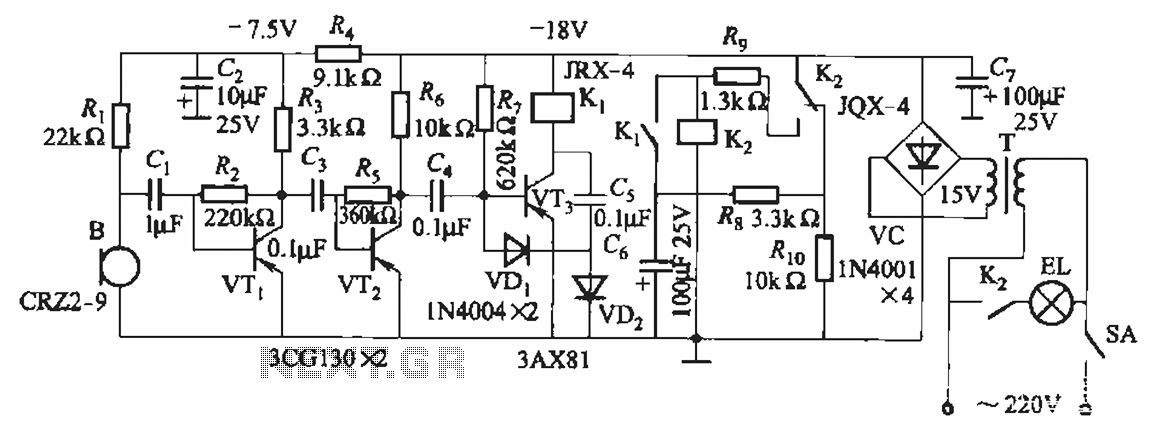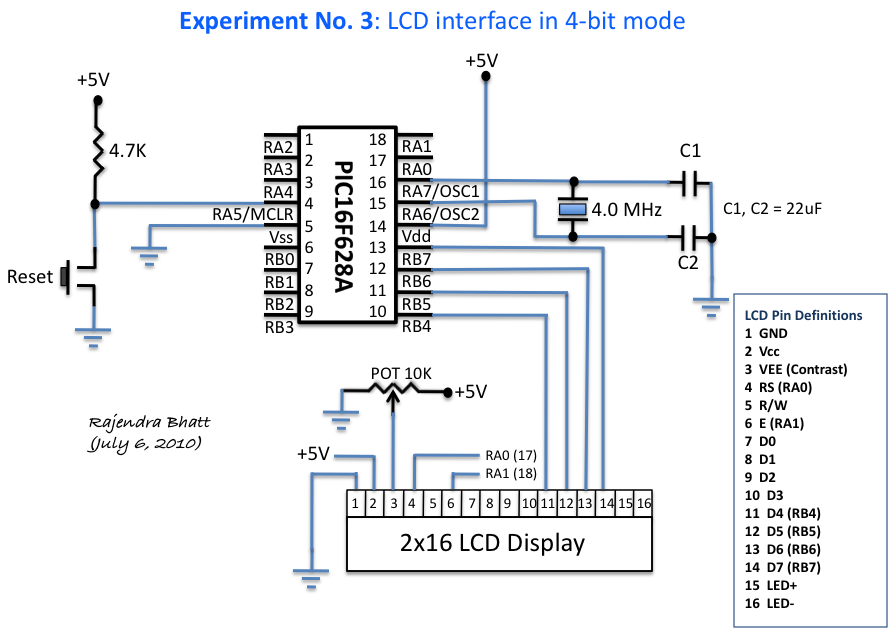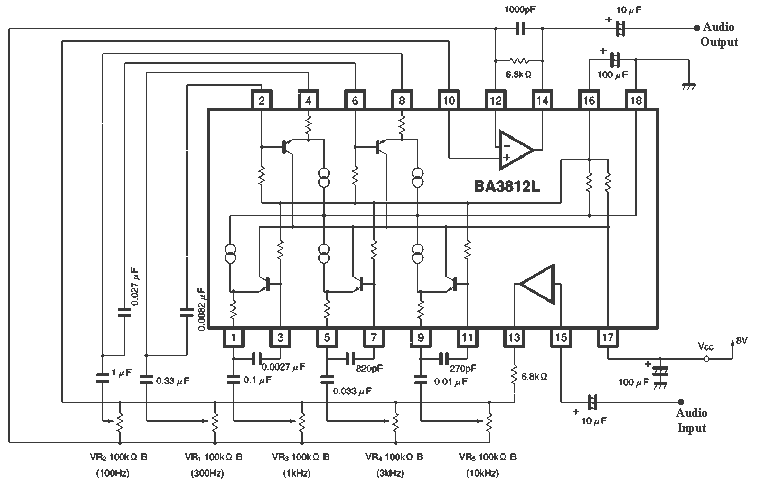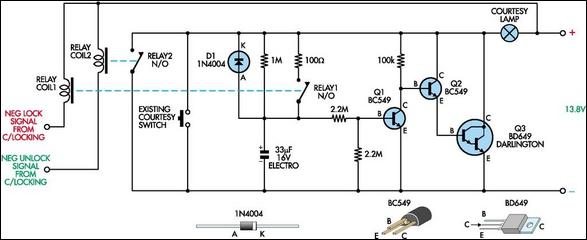
Automatic Light Controller Using 7806 And LDR PCB
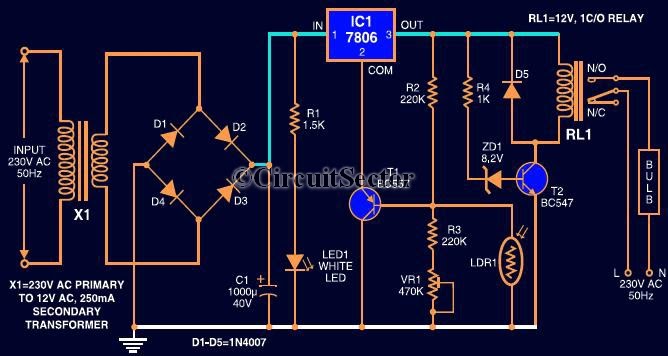
This circuit automates the control of street or porch lights. The automatic lamp controller circuit utilizes a 7806 voltage regulator IC, which can be employed to automate street lights, tube lights, or any other home electrical lighting systems. The IC 7806 is designed to provide a steady output voltage despite varying DC input voltages. The voltage present at the common terminal of this IC is mirrored at the output. When the ground terminal is disconnected, the input voltage appears at the output. The circuit is straightforward; a BC557 transistor drives the common terminal of the 7806. For automatic light control, the base of the transistor is connected to a Light Dependent Resistor (LDR). This configuration allows the voltage regulator to operate a light bulb automatically based on ambient light levels. The light sensitivity can be adjusted using a variable resistor (VR1) preset. During the daytime, the transistor (T1) remains on, and the output of IC1 is 6V, which is insufficient to energize the relay. However, at night, the output from the 7806 becomes the input voltage, causing the relay to activate.
The circuit design comprises several key components that work together to achieve automatic lighting control. The 7806 voltage regulator IC is pivotal in maintaining a constant voltage output, ensuring that the connected devices receive a stable power supply regardless of fluctuations in the input voltage. This feature is particularly useful in outdoor lighting applications where voltage stability is crucial for reliable operation.
The BC557 transistor serves as a switch in the circuit. Its base is connected to the LDR, which changes resistance based on the ambient light conditions. When the light level drops below a certain threshold, the resistance of the LDR increases, allowing the transistor to turn on. This activation of the transistor enables the current to flow from the 7806 output, which in turn energizes the relay connected to the lighting system.
The adjustable sensitivity of the light control is facilitated by the variable resistor (VR1). This component allows users to set the desired light level at which the circuit will activate the relay. By tuning VR1, the responsiveness of the circuit to light changes can be optimized for different environments or user preferences.
In nighttime conditions, as the ambient light diminishes, the LDR's resistance increases, triggering the BC557 transistor to conduct. The output voltage from the 7806 then rises to the input voltage level, which is sufficient to energize the relay. This action closes the relay contacts, allowing power to flow to the connected lighting system, thereby illuminating the area as intended.
Overall, this automatic lamp controller circuit is a practical solution for efficient outdoor lighting management, providing convenience and energy savings by ensuring that lights are only activated when necessary.This circuit controls the switching of the street light or porch light and it will be automated. This circuit of automatic lamp controller using 7806 regulator ic can be used to automate street lights, tube lights or any other house electrical lightning systems. the IC 7806 is a voltage regulator ic that give a steady output voltage against widely fluctuating dc input voltage. For this IC, any voltage that appears in common terminal will be reflected at the output. So when the ground terminal is disconnected, the input is available at the output. By the way the circuit is self explanatory, i will give you a simple description. The 7806 common terminal is driven by a BC557 transistor. for automatic light control, the base of this transistor is connected through a LDR In this way, the voltage regulator is able to operate a light bulb automatically as per the ambient light. The light sensing level can be adjusted by using VR1 preset. During day time, the transistor T1 will be on and the IC1 output will be 6V that is not much to energize the relay.
During night the 7806 output will be the input voltage and the relay become energized. 🔗 External reference
The circuit design comprises several key components that work together to achieve automatic lighting control. The 7806 voltage regulator IC is pivotal in maintaining a constant voltage output, ensuring that the connected devices receive a stable power supply regardless of fluctuations in the input voltage. This feature is particularly useful in outdoor lighting applications where voltage stability is crucial for reliable operation.
The BC557 transistor serves as a switch in the circuit. Its base is connected to the LDR, which changes resistance based on the ambient light conditions. When the light level drops below a certain threshold, the resistance of the LDR increases, allowing the transistor to turn on. This activation of the transistor enables the current to flow from the 7806 output, which in turn energizes the relay connected to the lighting system.
The adjustable sensitivity of the light control is facilitated by the variable resistor (VR1). This component allows users to set the desired light level at which the circuit will activate the relay. By tuning VR1, the responsiveness of the circuit to light changes can be optimized for different environments or user preferences.
In nighttime conditions, as the ambient light diminishes, the LDR's resistance increases, triggering the BC557 transistor to conduct. The output voltage from the 7806 then rises to the input voltage level, which is sufficient to energize the relay. This action closes the relay contacts, allowing power to flow to the connected lighting system, thereby illuminating the area as intended.
Overall, this automatic lamp controller circuit is a practical solution for efficient outdoor lighting management, providing convenience and energy savings by ensuring that lights are only activated when necessary.This circuit controls the switching of the street light or porch light and it will be automated. This circuit of automatic lamp controller using 7806 regulator ic can be used to automate street lights, tube lights or any other house electrical lightning systems. the IC 7806 is a voltage regulator ic that give a steady output voltage against widely fluctuating dc input voltage. For this IC, any voltage that appears in common terminal will be reflected at the output. So when the ground terminal is disconnected, the input is available at the output. By the way the circuit is self explanatory, i will give you a simple description. The 7806 common terminal is driven by a BC557 transistor. for automatic light control, the base of this transistor is connected through a LDR In this way, the voltage regulator is able to operate a light bulb automatically as per the ambient light. The light sensing level can be adjusted by using VR1 preset. During day time, the transistor T1 will be on and the IC1 output will be 6V that is not much to energize the relay.
During night the 7806 output will be the input voltage and the relay become energized. 🔗 External reference
